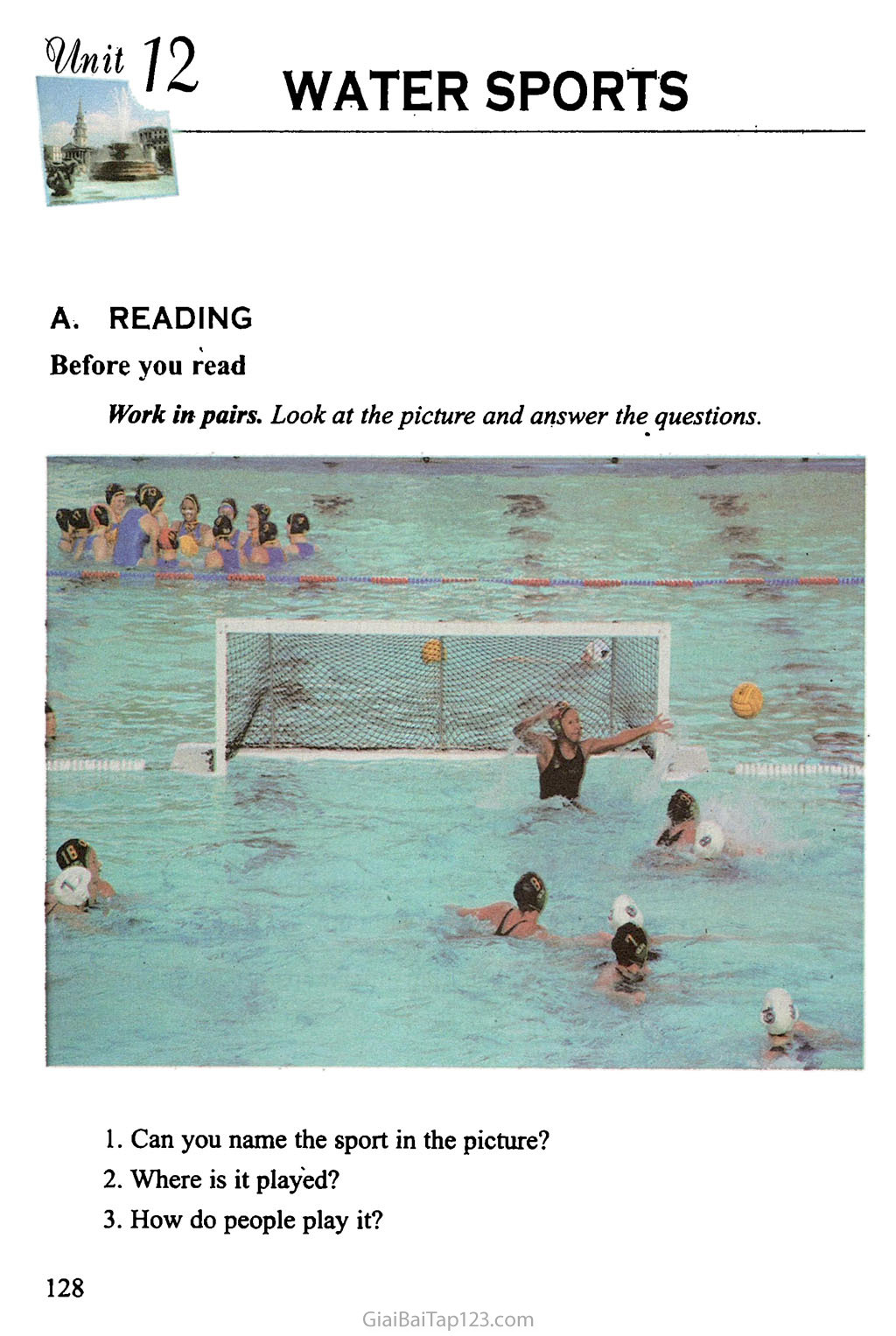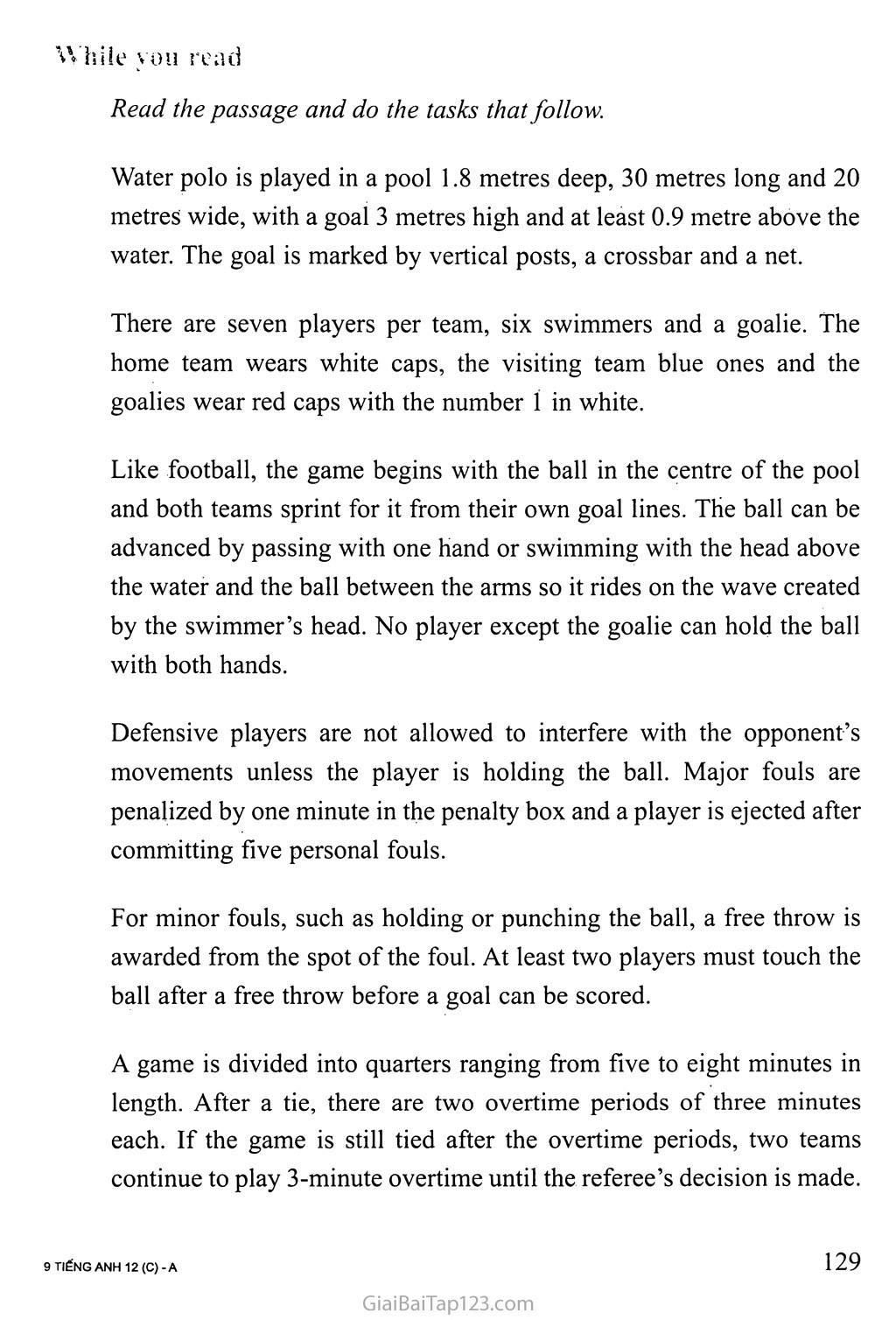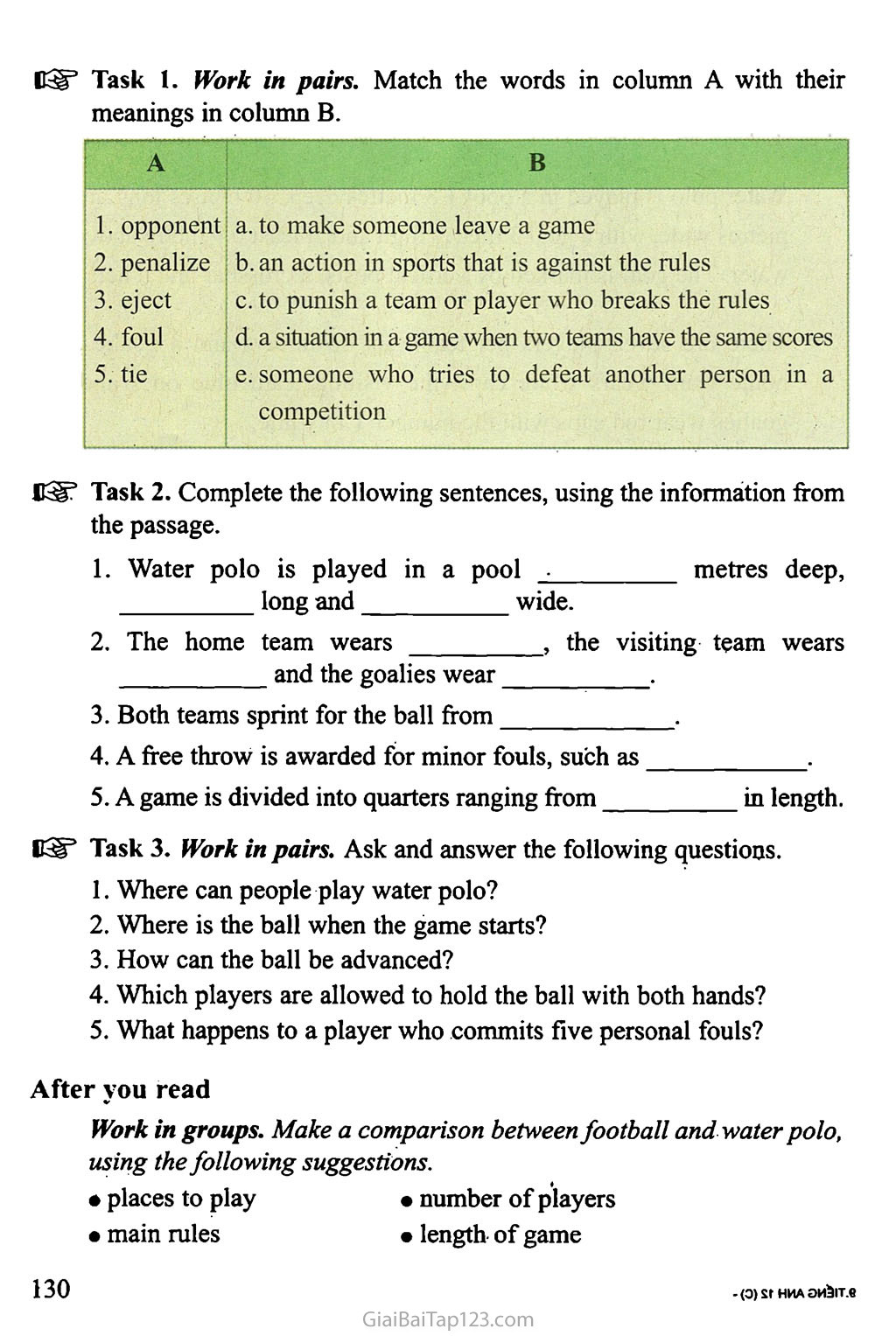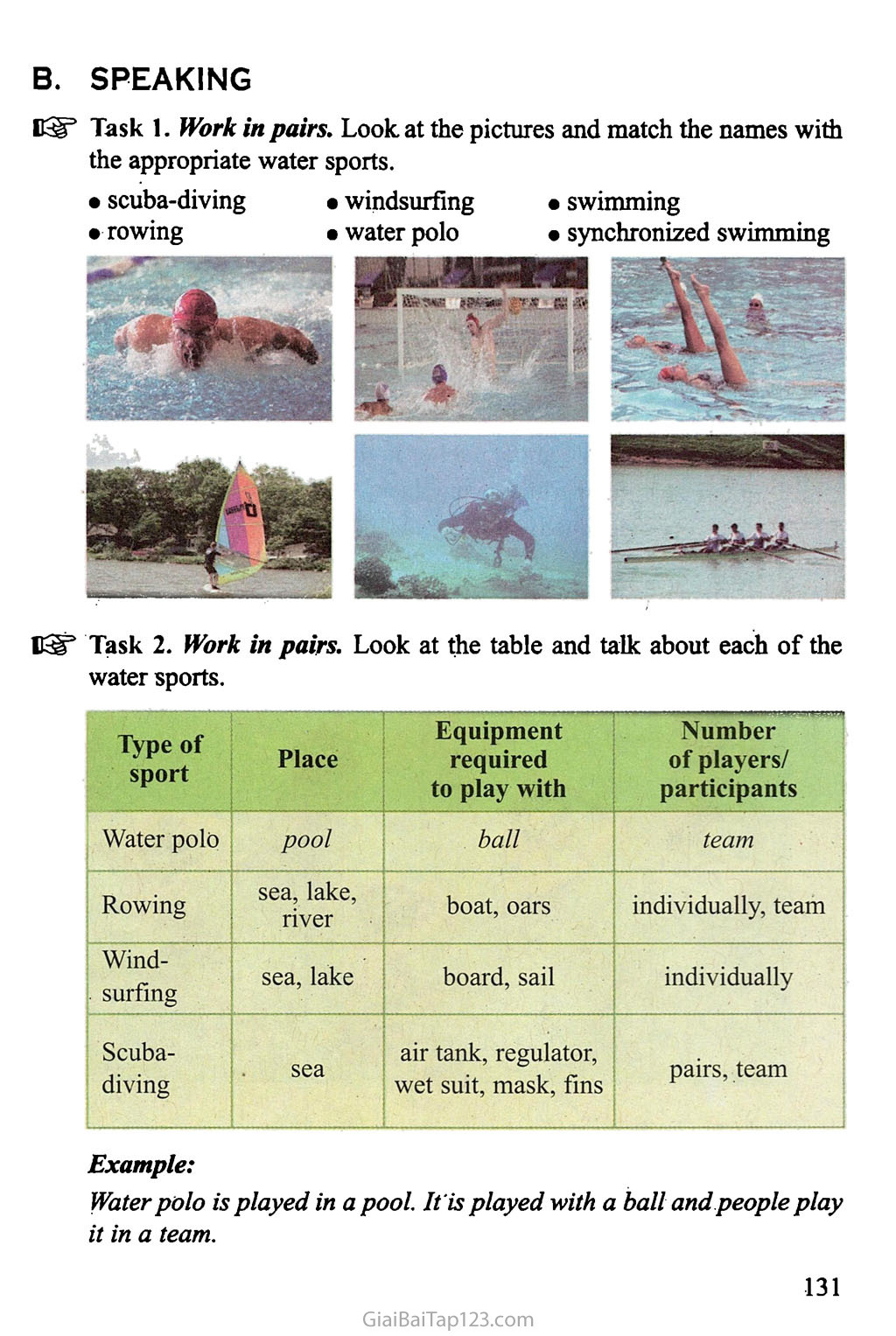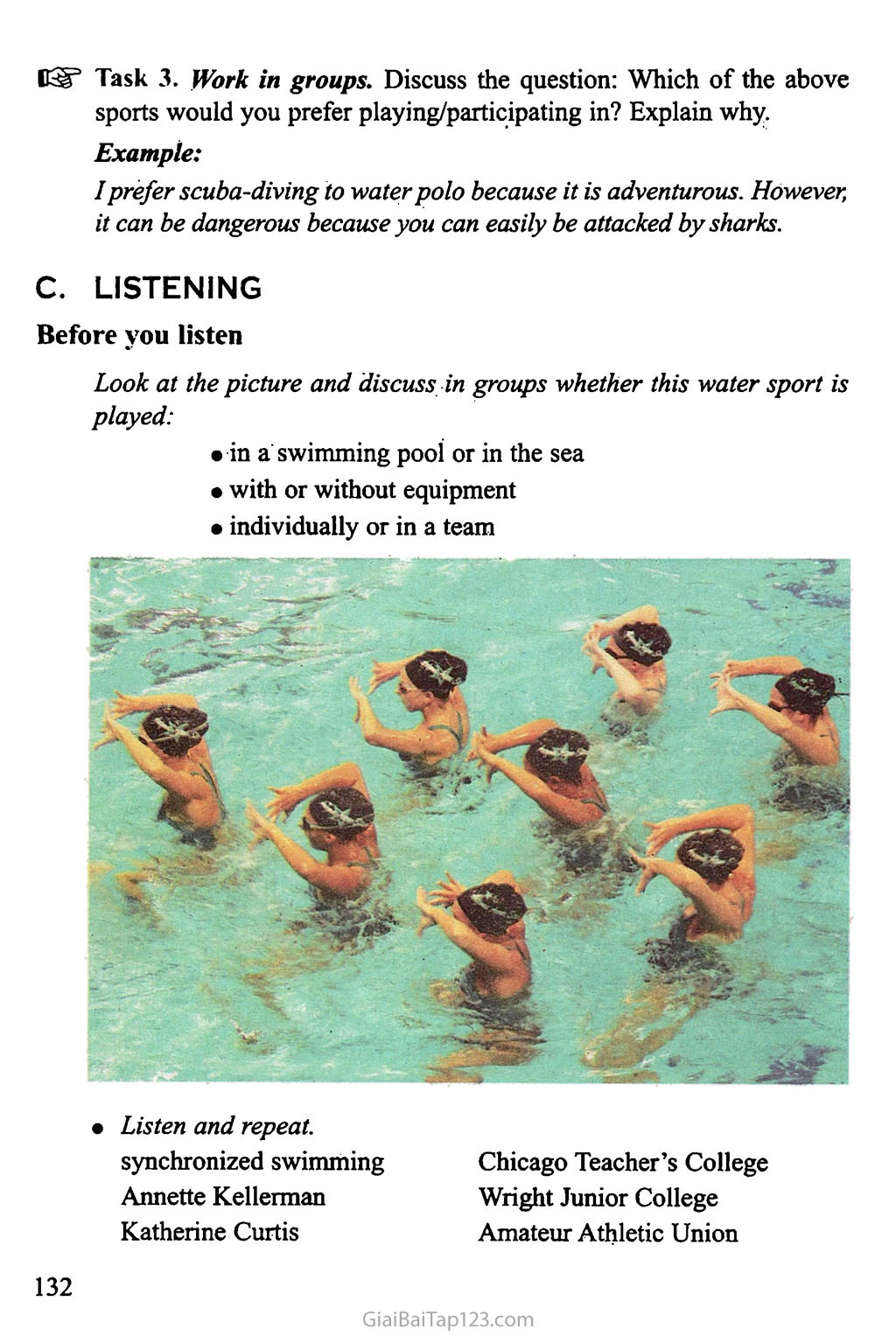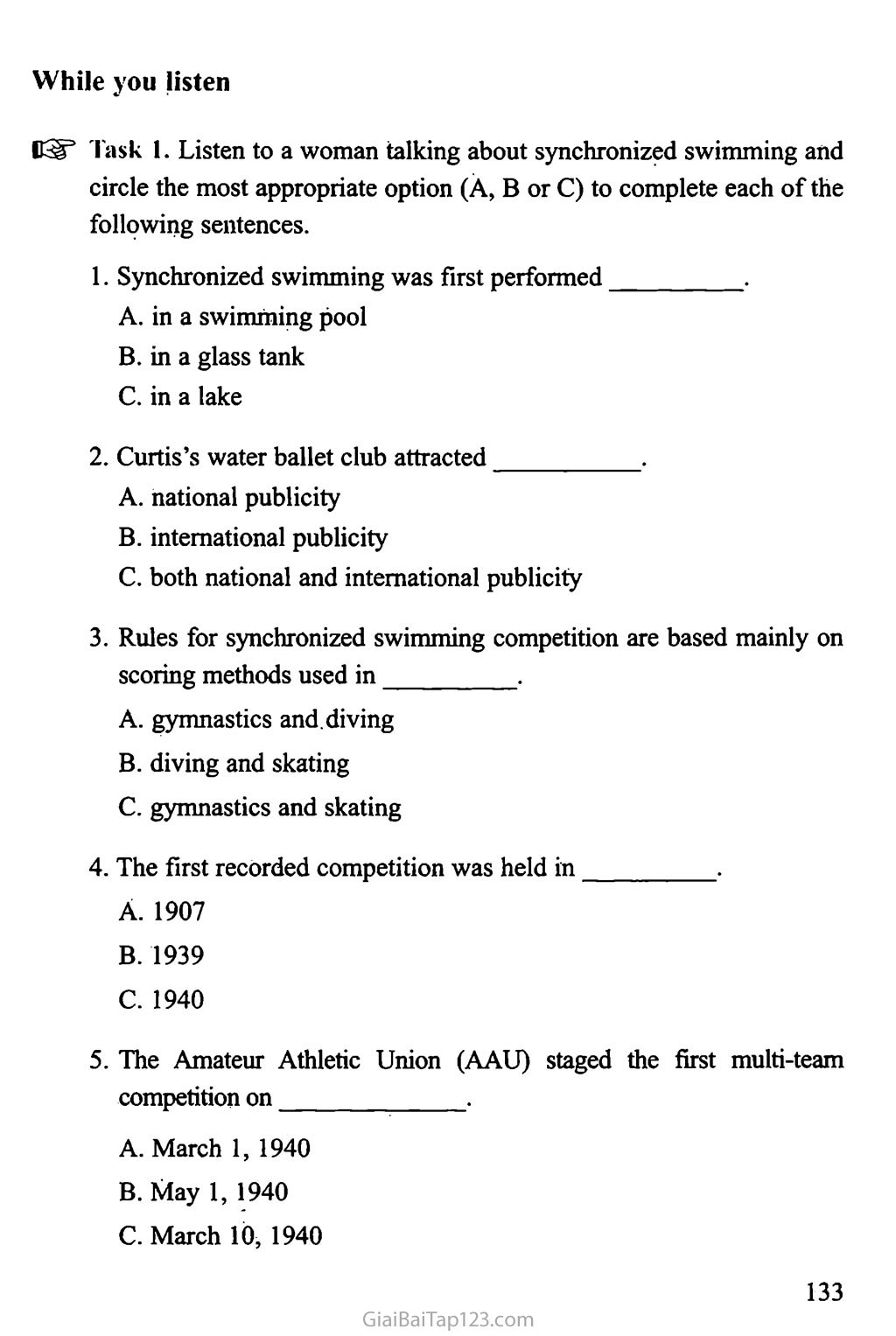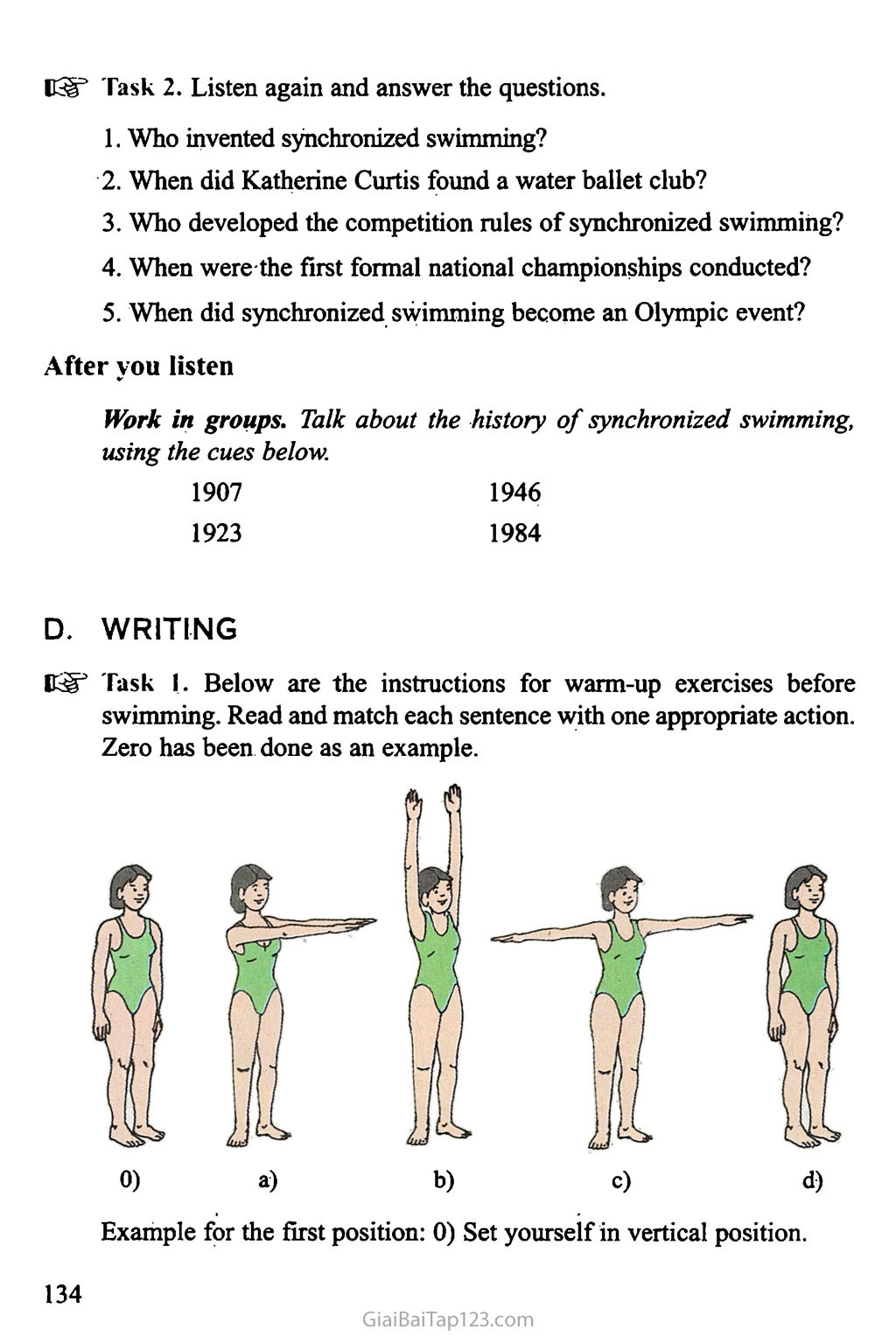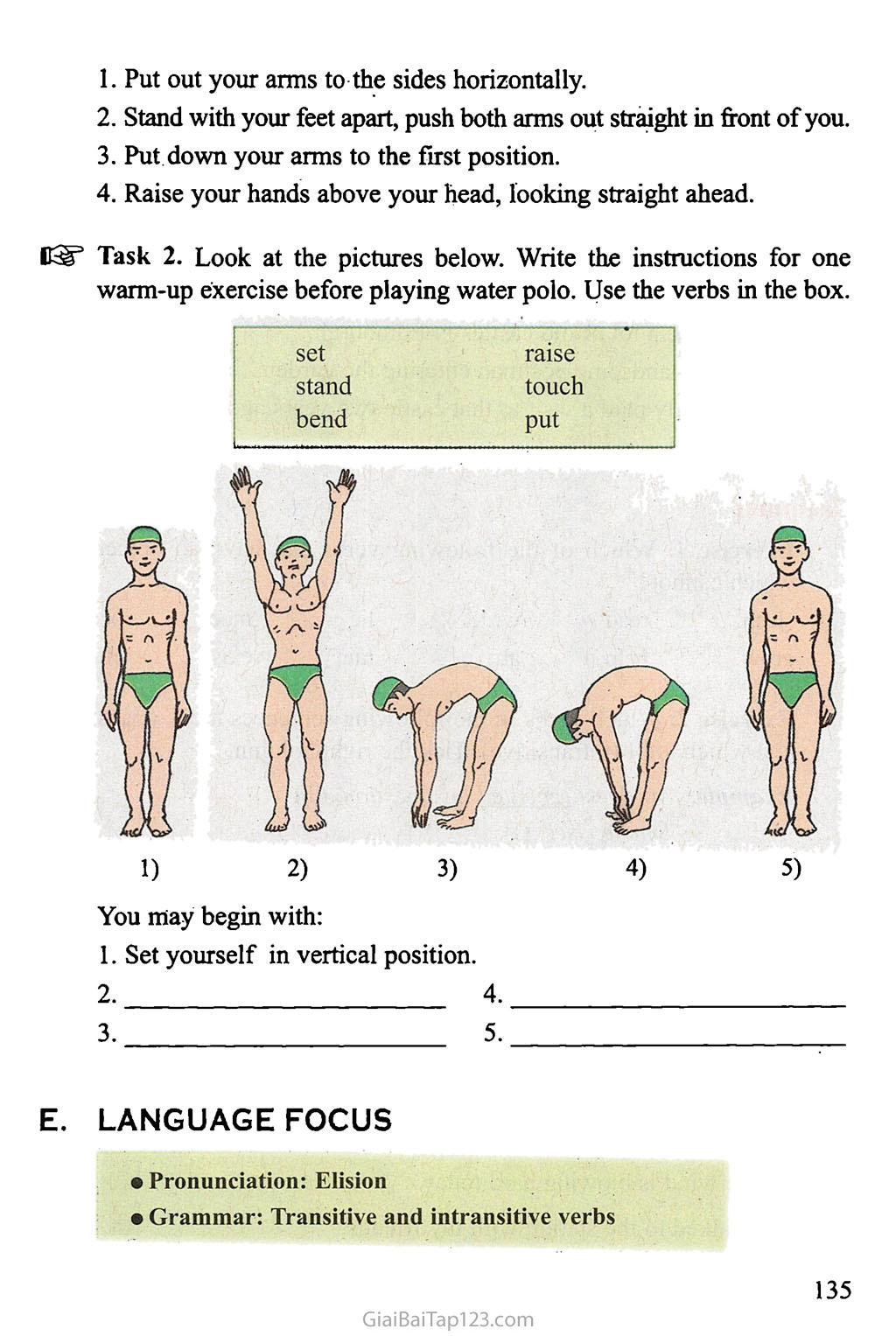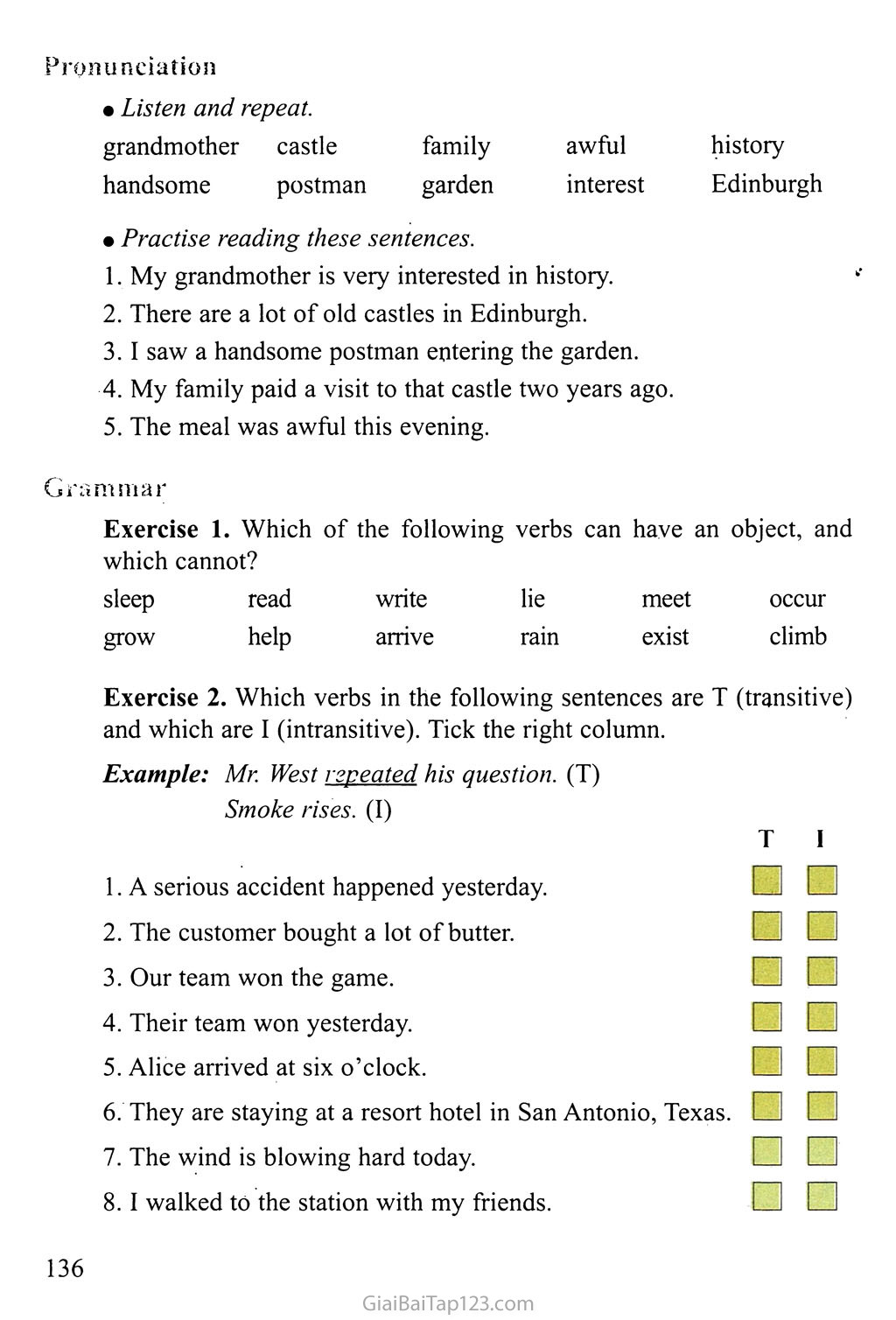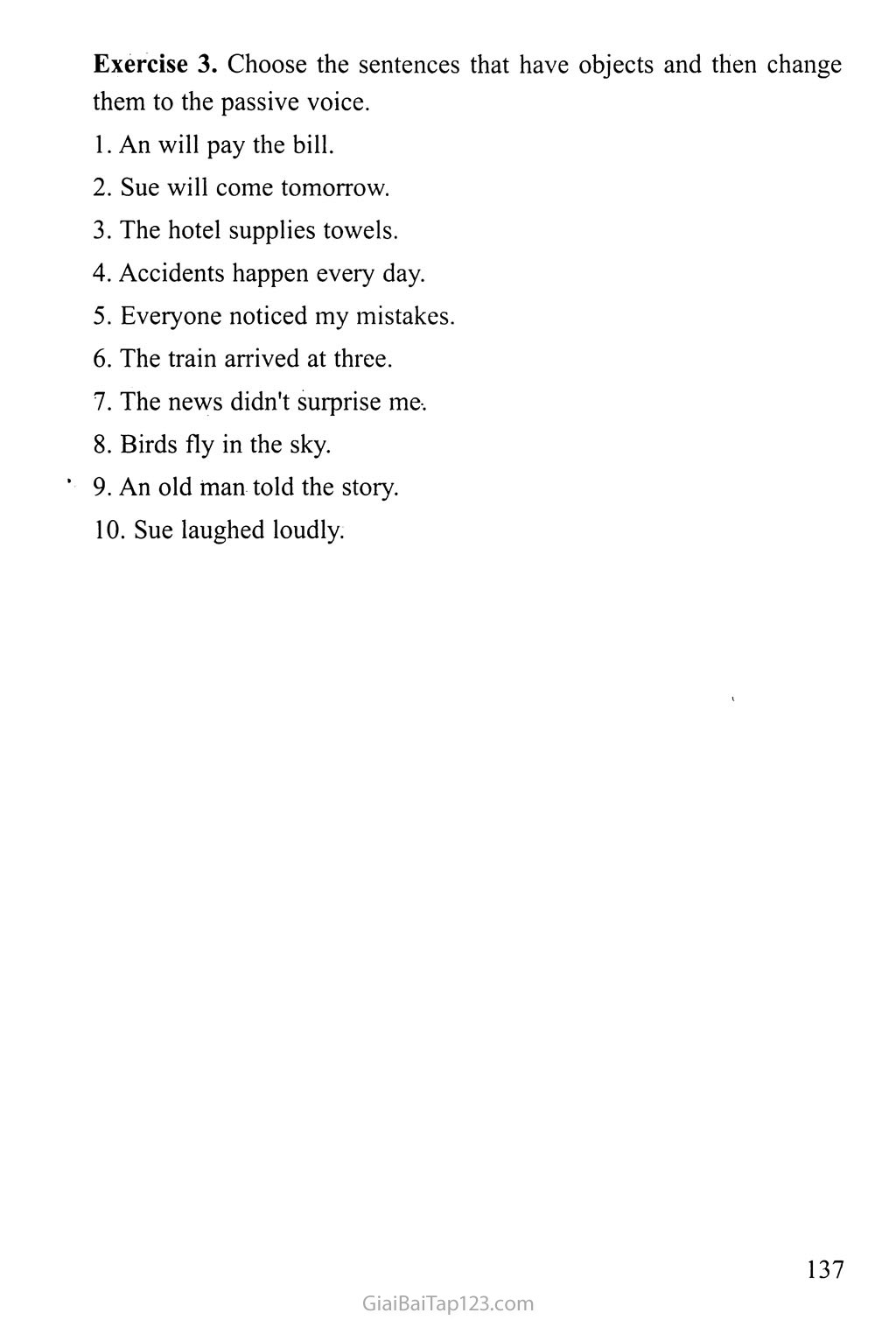SGK Tiếng Anh 12 - Unit 12: WATER SPORTS
'bhi'it J J A. READING Before you read WATER SPORTS A. READING Before you read Work in pairs. Look at the picture and answer the questions. Can you name the sport in the picture? Where is it played? How do people play it? While you read Read the passage and do the tasks that follow. Water polo is played in a pool 1.8 metres deep, 30 metres long and 20 metres wide, with a goal 3 metres high and at least 0.9 metre above the water. The goal is marked by vertical posts, a crossbar and a net. There are seven players per team, six swimmers and a goalie. The home team wears white caps, the visiting team blue ones and the goalies wear red caps with the number i in white. Like football, the game begins with the ball in the centre of the pool and both teams sprint for it from their own goal lines. The ball can be advanced by passing with one hand or swimming with the head above the water and the ball between the amis so it rides on the wave created by the swimmer’s head. No player except the goalie can hold the ball with both hands. Defensive players are not allowed to interfere with the opponent’s movements unless the player is holding the ball. Major fouls are penalized by one minute in the penalty box and a player is ejected after committing five personal fouls. For minor fouls, such as holding or punching the ball, a free throw is awarded from the spot of the foul. At least two players must touch the ball after a free throw before a goal can be scored. A game is divided into quarters ranging from five to eight minutes in length. After a tie, there are two overtime periods of three minutes each. If the game is still tied after the overtime periods, two teams continue to play 3-minute overtime until the referee’s decision is made. Task , Work in pairs. Match the words in column A with their meanings in column B. A B opponent penalize eject foul tie to make someone leave a game an action in sports that is against the rules to punish a team or player who breaks the rules a situation in a game when two teams have the same scores someone who tries to defeat another person in a competition Complete the following sentences, using the information from the passage. Water polo is played in a pool metres deep, long and wide. The home team wears , the visiting team wears A game is divided into quarters ranging from in length. Work in pairs. Ask and answer the following questions. Where can people play water polo? Where is the ball when the game starts? How can the ball be advanced? Which players are allowed to hold the ball with both hands? What happens to a player who commits five personal fouls? After you read Work in groups. Make a comparison between football and water polo, using the following suggestions. places to play • number of players main rules • length of game B. SPEAKING Work in pairs. Look at the pictures and match the names with the appropriate water sports. Work in pairs. Look at the table and talk about each of the water sports. Type of sport Place Equipment required to play with Number of players/ participants Water polo pool ball team Rowing sea, lake, river boat, oars individually, team Wind surfing sea, lake - ■ board, sail individually ■ Scuba diving sea air tank, regulator, wet suit, mask, fins ■ pairs, team i Example: Water polo is played in a pool. It is played with a ball and people play it in a team. Work in groups. Discuss the question: Which of the above sports would you prefer playing/participating in? Explain why. Example: I prefer scuba-diving to water polo because it is adventurous. However, it can be dangerous because you can easdy be attacked by sharks. Look at the picture and discuss in groups whether this water sport is played: in a swimming pool or in the sea with or without equipment individually or in a team • Listen and repeat. synchronized swimming Annette Kellerman Katherine Curtis Chicago Teacher’s College Wright Junior College Amateur Athletic Union While you listen Listen to a woman talking about synchronized swimming and circle the most appropriate option (A, B or C) to complete each of the following sentences. Synchronized swimming was first performed . in a swimming pool in a glass tank c. in a lake Curtis’s water ballet club attracted . national publicity international publicity c. both national and international publicity Rules for synchronized swimming competition are based mainly on scoring methods used in . gymnastics and diving diving and skating c. gymnastics and skating The first recorded competition was held in . 1907 1939 c.1940 The Amateur Athletic Union (AAƯ) staged the first multi-team competition on . March 1, 1940 May 1, 1940 c. March 10, 1940 Listen again and answer the questions. Who invented synchronized swimming? When did Katherine Curtis found a water ballet club? Who developed the competition rules of synchronized swimming? When were the first formal national championships conducted? When did synchronized swimming become an Olympic event? After you listen Work in groups. Talk about the history of synchronized swimming, using the cues below. 1907 1946 1923 1984 D. WRITING Below are the instructions for warm-up exercises before swimming. Read and match each sentence with one appropriate action. Zero has been done as an example. Example for the first position: 0) Set yourself in vertical position. Put out your arms to the sides horizontally. Stand with your feet apart, push both arms out straight in front of you. Put down your arms to the first position. Raise your hands above your head, looking straight ahead. Task 2. Look at the pictures below. Write the instructions for one warm-up exercise before playing water polo. Use the verbs in the box. 2) 3) 4) set raise stand touch bend put You may begin with: Set yourself in vertical position E. LANGUAGE FOCUS Pronunciation: Elision Grammar: Transitive and intransitive verbs Pronunciation Listen and repeat. grandmother castle family awful history handsome postman garden interest Edinburgh Practise reading these sentences. My grandmother is very interested in history. There are a lot of old castles in Edinburgh. I saw a handsome postman entering the garden. My family paid a visit to that castle two years ago. The meal was awful this evening. Grammar Exercise 1. Which of the following verbs can have an object, and which cannot? sleep read write lie meet occur grow help arrive rain exist climb Exercise 2. Which verbs in the following sentences are T (transitive) and which are I (intransitive). Tick the right column. Example: Mr. West repeated his question. (T) Smoke rises. (I) T I A serious accident happened yesterday. The customer bought a lot of butter. Our team won the game. □ □ □ □ □ □ Their team won yesterday. □ □ Alice arrived at six o’clock. □ □ They are staying at a resort hotel in San Antonio, Texas. □ □ The wind is blowing hard today. □ □ I walked to the station with my friends. □ □ Exercise 3. Choose the sentences that have objects and then change them to the passive voice. An will pay the bill. Sue will come tomorrow. The hotel supplies towels. Accidents happen every day. Everyone noticed my mistakes. The train arrived at three. The news didn't surprise me-. Birds fly in the sky. An old man told the story. Sue laughed loudly.

